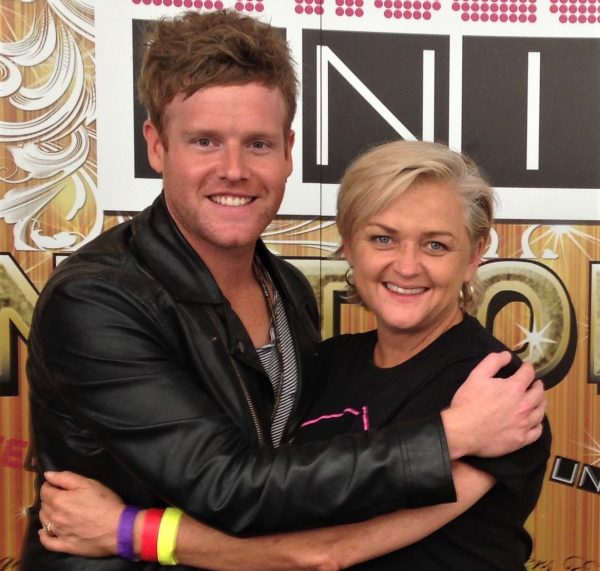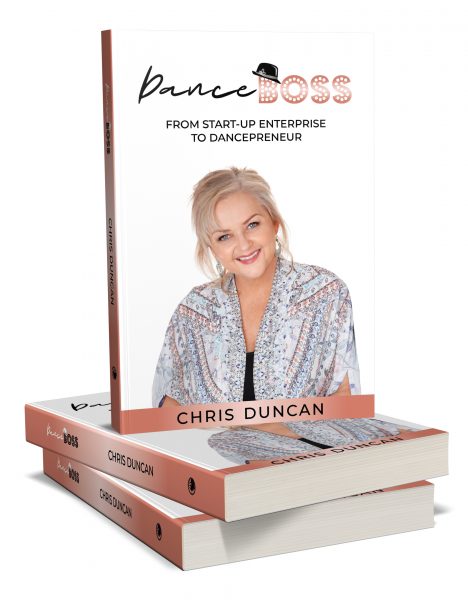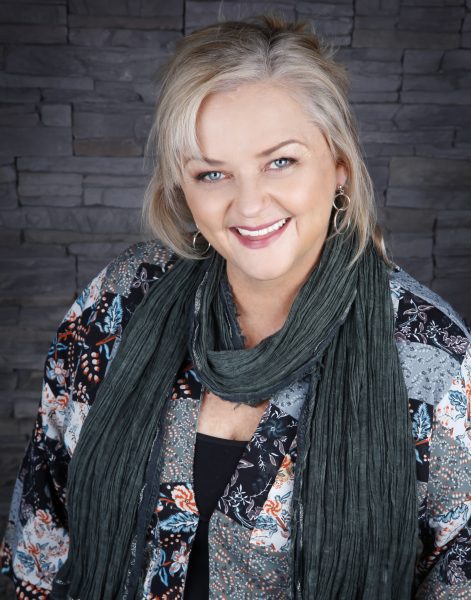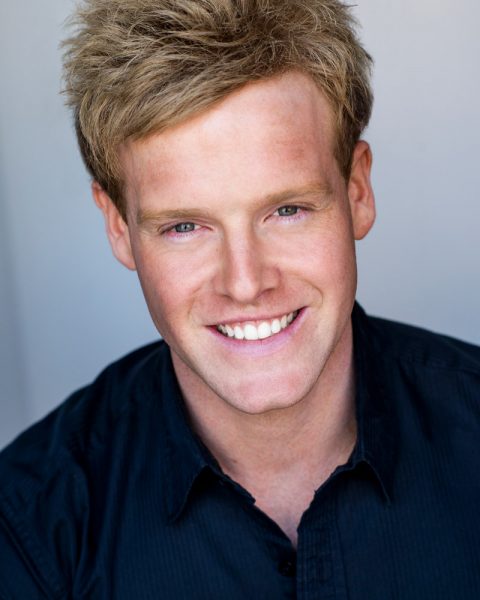Chris Duncan Features in US Podcast with Clint Salter
‘From Start Up Enterprise to Dancepreneur’
by Special Guest Contributor Clint Salter

Around ten years ago, regional-town dance studio owner and teacher Chris Duncan met ambitious dance entrepreneur Clint Salter. They hit it off. Soon after, Duncan was the proud new owner of Salter’s single-event business DanceLife. This is her story.
International champion of all-things-dance, Clint Salter, CEO of US-based Dance Studio Owners Association, recently featured our own Chris Duncan on his popular US podcast ‘Transform My Dance Studio’ to discuss Chris’ journey in the dance industry as well as their decade-long personal connection through DanceLife Unite in Australia. With the release of Chris’ first book DanceBoss, she discussed with Clint her insights and knowledge about how she battled and ultimately succeeded in the dance industry, as both a studio owner and event entrepreneur, by taking risks, over coming many hurdles and ultimately doing what she believes in by following her passions.
Clint has kindly allowed us to publish his Podcast with Chris Duncan in transcript form below. If you would like to listen to the lively, exuberant full podcast version conversation please go to:
or
***
CLINT SALTER: Hey everyone, it’s Clint Salter, thank you so much for joining us today for a very special interview. I am so excited, if you haven’t heard of this lovely woman before I’m going to introduce you to her today. Her name is Chris Duncan. She is the CEO of DanceLife, which we are going to talk about and DanceLife Unite over in Australia. She has a brand new book out called DanceBoss, which I’m so excited to dive into today. Chris, thank you so much for joining us. It is great to connect and have you on our podcast.
CHRIS DUNCAN: Hi, Clint, thank you so much for having me.
CLINT: So Chris, why don’t we start with how we connected initially, and I’d love for you to share a bit about the DanceLife journey.
CHRIS: Actually, you and I met back in 2011 and it was at a time where I was sort of a little bit in limbo. I had sold my second dance studio and I was really not quite sure of my direction of where I was going. I was dabbling in a few little side gigs here and there, I was doing a bit of study and that type of thing, but I wasn’t really quite sure what I wanted to do. I was still obviously very involved in the dance industry as I had been since the 1980S; 1987 was my first studio. But I met you in 2011, I came and I helped out at one of your events and we kicked off with a great friendship from there. And then by 2012, you were selling your incredible DanceLife Australia digital magazine and DanceLife Unite group dance competition. And at that time I thought, “that’s it, that’s what I’m going to do, I’m going to dive in”. And at that time you had successfully launched both of those businesses and they’d been running for three or four years. And I yeah, absolutely fell in love with everything that you had created and decided to run with it and go from there.
CLINT: You’ve had it and grown it and built it ever since. It’s been such a pleasure to see you take it to new levels and new chapters. You actually opened your first dance business at 19. What did that start-up journey look like for you during those years?
 CHRIS: Well, it was a really long time ago. I actually had two studios across my career. I opened my first studio back in 1987. And that was back in the day when most dance studios were taught from church or community halls or school auditoriums or gymnasiums or sports centres. So you didn’t actually have your own venue to go to to call your home. I’d turn up with my ghetto blaster, which was a massive portable tape deck, with all my mixtapes and I’d be dressed in my leg warmers and my fluoro tights and leotard and headband. And, I had questionably permed hair back then. I’d teach almost every weeknight and all day Saturdays. I taught at several different locations across my local region, and within less than three years, my little hobby studio had grown from just three students to over 150. At that time, I’d always considered my dance teaching as a bit of a side gig. I hadn’t really considered it as a full-time occupation. I’d also been working a nine-to-five job, firstly, in a bank as a bank teller and then later in a city-based administrative support role, and that required a three-hour daily round trip by train.
CHRIS: Well, it was a really long time ago. I actually had two studios across my career. I opened my first studio back in 1987. And that was back in the day when most dance studios were taught from church or community halls or school auditoriums or gymnasiums or sports centres. So you didn’t actually have your own venue to go to to call your home. I’d turn up with my ghetto blaster, which was a massive portable tape deck, with all my mixtapes and I’d be dressed in my leg warmers and my fluoro tights and leotard and headband. And, I had questionably permed hair back then. I’d teach almost every weeknight and all day Saturdays. I taught at several different locations across my local region, and within less than three years, my little hobby studio had grown from just three students to over 150. At that time, I’d always considered my dance teaching as a bit of a side gig. I hadn’t really considered it as a full-time occupation. I’d also been working a nine-to-five job, firstly, in a bank as a bank teller and then later in a city-based administrative support role, and that required a three-hour daily round trip by train.
So, dance was very much a side gig for me, but that little hobby business was generating quite a large percentage of my income. And I actually learned from that how to create something from nothing. I knew nothing about business. I just had to rely on myself and I had to learn the importance of developing a sense of leadership with my assistant teaching staff and my students. And that’s something that I really struggled with at first. But I also learned to multitask and synchronise my time because I had to juggle everything I’d signed myself up for: because I was also performing in local corporate gigs and also doing promotional work, judging local talent quests as well as choreographing and managing a cheerleading squad on top of my day job.
I realised that I hated being idle. And I also learned to master old-school type marketing processes, like newspaper ads and hard-copy flyers and a telephone book advert. Nobody remembers those now. But you know, all those old-school types of advertising and promotional marketing opportunities that you just don’t really kind of think of today … they’re still very powerful if you do engage them. And we used to do shopping centre shows and local community appearances and that type of thing. And our dancers even appeared on TV. I really loved that period, but it was very rudimentary. I sold that first business in 1990 because I was getting married, but I did begin my second dance studio just five years later.
CLINT: If there’s something you haven’t already figured out about Chris, is that she loves being busy. You mentioned about your ‘why’ … What is that process for really discovering that deep understanding of ‘why do I do what I do’?
CHRIS: I don’t think I personally discovered my ‘Why’ until I began my second studio in 1995. And it’s something that I realised was seriously lacking in my dance studio business. I was a little older, a little wiser, and by then I had a young family; in fact, two weeks after I opened my second studio, I gave birth to my third child, my son. And he was my third child under four years of age, so yes, I was insane! I know I’m a bit of an overachiever but I just don’t like to be idle. But my ‘why’ became very much about my family. So family was always first, but I also wanted to create exceptional experiences for as many young dancers in my care as I could. And that came from not having had those experiences myself as a kid, like big dream goals and things like that. So I became extremely passionate about making dreams come true for other people, because it really gave me a lot of joy and that became my ‘why’, but also being passionate about supporting other people and their dreams.
So for my second studio, that included bringing our Aussie kids across to perform at Disneyland in California, which maybe not be such a big deal for American studios, but it’s a really big a deal for Australian kids. And it also included creating performance opportunities for them at all of Australia’s major theme parks. We also created performance opportunities on a cruise ship for them. I also worked really hard at placing a number of my top dancers in jobs around the global. So when things get tough, especially in the last couple of years … without our ‘why’ and a strong sense of purpose, it’s all too easy to give up and go and cry in the corner.
CLINT: I really loved how you said your ‘why’ evolves. I think a lot of people feel bad that the same things aren’t as important to them as they used to be. During the pandemic we’ve seen so many of our studio owners question why they are working 70 hours a week?
CHRIS: Absolutely, for your business to be a success, it needs to be a business that can give you that time and freedom and full creativity for whatever you want to be able to do within your life, because otherwise you’ve just created yourself a job, and that’s not what we’re in business for. At the beginning obviously we want to do everything, but ultimately we want to create freedom for ourselves and our family or those that are close to us.
CLINT: Chris, I think we both have the same mindset, you and I are both into personal development. Share with us some of your mindset tips and strategies to help our studio owners power forward and keep moving in the right direction.

CHRIS: This is something that I’ve had to really focus on a great deal myself. In the dance studio game so much of our success doesn’t rely just on our talent and skill, but also on our mindset and how we navigate the inevitable challenges that any business faces. So in business in general, everyone has typical hurdles, but dance studio owners are also at the mercy of a lot of expectation and judgment and competition. It’s really imperative for studio owners to take care of their mental game, as well as the physical business aspects in order to survive and to thrive, and to be able to grow their dance business the way they want to.
My three top tips would be: First, to tame your inner critic. I’ve got a whole chapter devoted to it, it’s chapter two, it’s one of my favourite chapters. That’s one of my first go-to’s, smash out affirmations every day! Put them everywhere, all over your fridge, all over your cupboards, even in your shower if you have to. I’m also a big believer in meditation. I’ve actually used hypnosis in the past as well, and I do go to that if I need to, if there’s something that’s really stuck there that I just can’t seem to move with meditation and affirmations.
Secondly, be really mindful of who you hang out with. Your ‘tribe’ really does affect your vibe and vice versa. Negative people considerably affect your ability to navigate the challenges of running and growing your amazing business. Be aware of who you surround yourself with, both professionally and personally. If they’re not in your corner, then they’re not really supporting you.
Thirdly, I’d have to say goal setting. It’s something that is really important for a clear mindset, because it helps you overcome the issue of procrastination and it gives you a really clear guidance system for you and your team. It really takes down a lot of the stress and anxiety around how things are going to get done in your business.
CLINT: They’re so practical, I can see how this is going to resonate deeply with the studio owners. Here at Dance Studios Owners Association we are huge fans of planning. I know you are a planner as well Chris. Talk to us a little bit about the elements of what we need to plan to be able to really create a successful business?
CHRIS: You definitely need to be focused; not only on what’s going on, right here right now, but where you want to be in the future. I’m a huge believer in setting long term goals, your 10-year goal, your 5-year goal, your 1-year goal definitely, so that you have a guidance system of where you’re going and it really helps anchor your ‘why’. So many people overlook their planning, both in the short term and long term. But so many of us are studio owners in startup, or even just beyond startup, and we’re just thinking about how we can go about paying the rent for this month, let alone our long term mission. Without that kind of guidance system of your planning, then things can go awry really quickly. It’s kind of like putting your toddlers on stage and asking them to improvise at the end of your recital, it could all end very badly. So, forming a mission statement is really a valuable framework for your culture and planning to be built on, and accountability to clients and the public.
But beyond your mission statement, you then have to make that part of your culture; that your team and your clients really they buy into and it becomes part of your business. You have to plan how that’s all going to come into being. And so, you know, break those plans down. So, 10 years, 5 years, 1 year, break that 1 year down into quarterly, monthly, weekly, even daily huddles. If you’ve got a studio where you are in there every single day, have a daily huddle with your team. And it only has to take five minutes, it’s just to really set and plan your day so that each of your goals get kicked. And that’s the important thing.

CLINT: This is like a little mini-training session right now. I love it! Let’s talk a little bit about marketing. Talk to us a little bit about how you approach marketing now?
CHRIS: Well, these days there’s a broad spectrum of marketing tools available, but many of them have free or low-cost entry points, which is fantastic. If only we had had social media back in the day, we would’ve certainly saved ourselves a lot of time, effort and money. Also you need to give your potential customers lots of multiple touchpoints or ways to learn about your dance studio through marketing. So, the touchpoints should be delivered by a suite of different avenues that your customer avatar has their eyeballs on. So it depends what they’re looking at, what they’re listening to, who they follow etc. And of course these days, top of mind is social media: Facebook, Instagram, TikTok in certain demographics, but social media isn’t the end of it, it’s not much if it’s not backed up by an effective email marketing protocol as well. We own our database, but a social media following can be taken away at any time, whereas an email database is yours and it’s a saleable asset within your business. You can achieve so much through your email marketing campaigns that you can’t achieve through your social media. Social media’s fantastic for so many reasons, but you shouldn’t make it your sole marketing platform.
There are lots of options a studio can employ in their marketing toolkit. And I do a dive deep into that in the book, but beyond social media and email the third one I’d like to highlight today would actually be your customer service and your customer journey as a powerful marketing tool. I actually consider great customer service to be one of your most influential marketing tools because it reflects your studio culture and you as a leader. Customer service, it’s totally free and it can act as a brilliant referral marketing scheme, and at the same time build your brand social proof. So it’s actually a brilliant marketing tool that most people don’t consider can be considered as a marketing tool as well.
CLINT: How do people get a copy of DanceBoss?
CHRIS: Well, I’ve just set up my new website: DanceBossPro. You can order the book online. And for orders that are made within the US or Canada or outside of Australia they’ll be delivered via our publishing house in those countries.
CLINT: I want to talk about money, because we find that a lot of studio owners can have an uncomfortable relationship with money and really focusing on profit. So I’d love your perspective on how our studio owners can get a better understanding of money and really improve their relationship with it.
CHRIS: This is often a tough one for a lot of people because so many of us are brought up with a negative mindset around money. But understanding the characteristics of money and what makes people want to spend theirs with you helps you streamline your marketing and your sales processes. It actually saves you time and effort and money itself if you actually understand the characteristics. First of all, your own beliefs around money – don’t fall into the trap of self-sabotage and self-limiting beliefs. If we have a simple belief pattern that, ‘I’m always broke’, or ‘I never have enough money’, that’s actually a negative affirmation.
But you need to address how money makes you feel. Does it make you feel stressed, excited, satisfied or desperate about it? If you’re feeling desperate about money, then it’s always going to be out of your reach. So you need to focus on how you feel about money and really change that by using some of the mindset tools that we mentioned before and that I dive deep into in the book. And also, when you are dealing with your customers, if you focus on how you are helping them, how you’re helping your customer instead of what you are gaining from that transaction, then that helps you shift the focus away from money. Money is just an exchange of energy. If you see that as offering your clients something extra, giving them an option, and if you focus on the benefit to them, then it takes the onus off being afraid to ask them to spend more money with you. There’s nothing wrong with having an exchange of money for good service.
CLINT: Chris, to wrap up, there’s so much amazing stuff in the book .. guys make sure you go and grab yourself a copy! Chris, what do you believe are the 3 ingredients to success in this very interesting, joyous, competitive, delightful, frustrating industry that we’re working in?
 CHRIS: Well, there are 3 ingredients that I do share in the my final chapter of my book, so I won’t divulge all three here, but I will give you my top 2. I think the first one that has helped me achieve my success over the last 35 years has been to develop and maintain a really teachable mindset. I wouldn’t have achieved even half my success I have if I hadn’t sought the assistance of multiple mentors and engaged in lots of different learning programs, both on a personal and professional level. I’ve spent well and truly over $120,000 just in the last 10 years engaging with multiple mentors and studying different programs, just to help me develop and improve in one way or another. I can’t express enough how much having a mentor really helps fast track your success and gives you your own support network and your own cheer squad in your own corner; spurring you on with lots of valuable knowledge and skills and processes that would take you years to learn yourself if you didn’t engage those people.
CHRIS: Well, there are 3 ingredients that I do share in the my final chapter of my book, so I won’t divulge all three here, but I will give you my top 2. I think the first one that has helped me achieve my success over the last 35 years has been to develop and maintain a really teachable mindset. I wouldn’t have achieved even half my success I have if I hadn’t sought the assistance of multiple mentors and engaged in lots of different learning programs, both on a personal and professional level. I’ve spent well and truly over $120,000 just in the last 10 years engaging with multiple mentors and studying different programs, just to help me develop and improve in one way or another. I can’t express enough how much having a mentor really helps fast track your success and gives you your own support network and your own cheer squad in your own corner; spurring you on with lots of valuable knowledge and skills and processes that would take you years to learn yourself if you didn’t engage those people.
The second one that I’ll share today is just being authentic; being a really authentic operator in this business. By all means admire other people, but stay in your own lane and do your own thing, be uniquely you and be really proud of your point of difference and what you can bring to the table. It’s really important to stay focused on what you can uniquely bring to the table and why you are in this game, rather than looking sideways and getting frustrated and stressed about what everyone else is doing.
And the third one, you’ll just have to find out by reading the book!
CLINT: Exactly! I love it, Chris, thank you so much for sharing your wisdom with us today. Remind us again, where can we go to grab our copy of the book DanceBoss?
CHRIS: My new website is dancebosspro.com, and I would like to offer three books to give away to your lovely audience Clint at your discretion. So that’s up to you!
CLINT: If you’d like a copy of Chris’s brand new book, DanceBoss, I would love for you to jump onto Instagram, do a story, tag Chris Duncan and Dance Studio Owner’s Association, and just share with us what was your biggest ‘aha’ moment from the interview with Chris was today? We’ll pick three lucky winners who’ll get a copy of the book.
So thank you so much Chris.
***
www.dancebosspro.com
www.clintsalter.com













